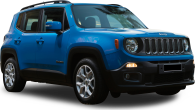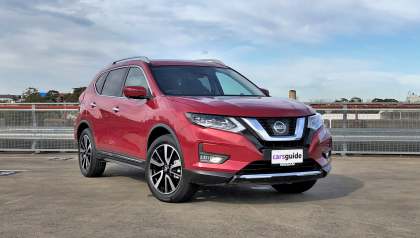If you're in the market for a mid-sized SUV then chances are your research has included at least more than a cursory glance at the Honda CR-V.
We tested a Honda CR-V VTi L7 for a week of real-world duties, which included a mix of driving, with some very light dirt tracks thrown in to see how this 2WD would perform when push comes to (ever so gentle) shove.
It’s a seven-seater SUV so, you would assume, it offers more flexibility in terms of people-carrying and packability for weekend trips and longer sojourns than its five-seater stablemate and, even though our test vehicle is not an all-wheel drive variant, it offers the opportunity for light-duty touring.
So is this CR-V worth your consideration?
Read on to find out.
Honda CR-V 2022: VTI L7 (2WD) 7 Seats
| Engine Type | Turbo 4, 1.5L |
|---|---|
| Fuel Type | Unleaded Petrol |
| Fuel Efficiency | 7.3L/100km (combined) |
| Seating | 7 |
| Price From | $31,240 - $37,620 |
| Safety Rating |
|
Does it represent good value for the price? What features does it come with?
At time of writing, the VTi L7 has a national driveway price of $43,490. This seven-seater has a 1.5-litre turbocharged four-cylinder petrol engine and is the second-from-top spec in the current CR-V line-up, along with a five-seat AWD variant in the same trim level.
This CR-V variant has an extensive features list and newer additions to that include a seven-inch touchscreen multimedia unit (with Apple CarPlay, Android Auto and Garmin sat nav), a hands-free power tailgate, wireless phone charging (on VTi L7 and VTi LX AWD grades), and dual zone climate control.
It also gets LED headlights, LED fog lights, privacy glass, a panoramic sunroof, and roof rails, in keeping with its sporty presence.

All CR-V trim levels have driver-assist tech under the umbrella of Honda Sensing and includes such safety wizardry as adaptive cruise control, lane keeping assist, forward collision warning, lane departure warning and more.
It rides on 18-inch alloy wheels shod with Toyo Proxes R45 tyres (235/60 R18).
Exterior paint colours include Platinum White pearlescent, Lunar Silver metallic, Brilliant Sporty Blue metallic, Modern Steel metallic, Crystal Black pearlescent, Ignite Red metallic, and Cosmic Blue metallic (on our test vehicle). Metallic or pearlescent paint do not incur an additional charge.
Is there anything interesting about its design?
SUVs, as popular as they are, all seem to occupy a comfortable middle-of-the-road niche, in terms of styling.
Nothing outrageous, nothing offensive. Nothing wrong with that. Just like my nan used to say about her grandkids’ haircuts: Why have a mullet when a short-back-and-sides will get you good looks every time?

The CR-V, as before, is on the right side of satisfactory, with a quietly pleasant interior and exterior.
The black-out grille, hidden door handles, and dual chrome exhaust finishers are all nice exterior touches.

What are the key stats for the engine and transmission?
The VTi L7 has the CR-V line-up’s 1.5-litre four-cylinder VTEC turbocharged petrol engine – producing 140kW at 5600rpm and 240Nm at 2000-5000rpm – and is paired to a CVT transmission able to be worked via steering wheel-mounted paddle shifters.

This match-up is a quietly sufficient, if unexciting, combination.
Note: this CR-V variant is front-wheel drive; it is not an all-wheel drive vehicle.
How practical is the space inside?
The CR-V is 4635mm long (with a 2660mm wheelbase), 1855mm wide, 1679mm high and it has a listed kerb weight of 1642kg.
It’s quite a roomy interior, for a medium SUV, and it’s also a tidy space, adequately equipped with storage places and user-friendly functionalities, including dual-zone climate control.
Upfront, the dash looks decent enough though the 7.0-inch touchscreen is too small I reckon, and the centre console was redesigned through the last round of major changes, two years ago.
Throughout the cabin everyone has access to enough phone-charging spots – there are four USB points in total, with two of those and a wireless charging pad upfront – and enough cup holders (10) and storage places scattered about the interior to keep even the fussiest of road-trippers among us happy.
There’s even a 12V outlet upfront.

Seats are reasonably comfortable all-round, except for the third row which is a bit of a punishment for anyone but young children or the most diminutive of your mates.
The driver’s seat has eight-way power adjustment and two-position memory; the front passenger seat has four-way power adjustment.
The 60:40 second-row seats are roomy enough; I sat behind my driving position and had a comfortable amount of head, leg and knee room.
In terms of child restraint points, the second row has three top tether and two ISOFIX points. There is a fold-down arm-rest with two cup holders, and there are two USB points and air-vent controls in the back of the centre console.
Third-row passengers also have air vents in their little kingdom.

While I’m talking about the third row it’s worth mentioning here that the rear doors open to 90-degrees, which is handy for getting in and out of the second or third rows, or loading and unloading gear/kids/groceries into either of those spaces.
Official cargo capacity is 150 litres with all three rows in use; 472 litres with the third row down; and 1486 litres with the second and third rows down and loaded up to the roof.
The full-size spare alloy wheel is under the rear floor cover.
The two-tiered cargo floor at the rear that can be folded flat is a nice touch, giving you some flexibility to separate loads (maybe wet beach towels in the bottom and dry gear on the shelf above), or just lay it flush to be a uniformly flat load space.
What's it like as a daily driver?
Not too bad, really – without ever being anywhere near exceptional or even exciting.
The driver’s seat is eight-way power adjustable, as mentioned earlier, and the steering column is tilt and telescopic adjustable so it’s easy enough to approximate your preferred driving position.
And steering has a balanced feel about it, if a tad too light, but that sensation does fit with the general medium-sized SUV feel of the CR-V, which will likely spend most of its time as a suburban or inner-city chariot. It has a listed minimum turning radius of 5.5m.
It’s a mid-size SUV so it’s a nimble enough around town and the CR-V’s 1.5-litre turbo engine and CVT make for a predictable, if lacklustre, pairing and throttle response is not too sharp.
However, if you do get the urge, you can play around with the steering wheel-mounted paddle shifters in an attempt to inject some more life into this 140kW/240Nm SUV.

The CR-V has a solid on-road stance and ride and handling are adequate, with a reliable general feel, but the suspension is on the wrong side of firm, and this Honda tends to become skippy at speed through rougher sections and it thumps through even shallow potholes.
Rolling rubber is Toyo Proxes R45 (235/60 R18) and the CR-V has a full-sized alloy spare wheel is under the floor in the rear cargo space.
There is plenty of driver-assist tech onboard and its LaneWatch system (which, when you use the left indicator, shows you the camera view back along the vehicle’s left-hand side) actually comes in handy, especially if you spend any time in a city where you’ll need to watch out for cyclists and other road users.
Otherwise, there is sufficient all-round visibility. The reversing camera view, depicted on the multimedia screen, while not big enough, is clear enough that you shouldn’t have any strife if you keep a close eye on that as you reverse.
What's it like for touring?
Let’s be honest – this is a two-wheel drive city-focussed SUV so you shouldn’t be taking this rock-crawling any time soon – and, of course, you’d be much better off with an AWD if you’re planning even short-distance forays onto well-maintained dirt roads – but there’s no reason why you can’t have your very own light-duty adventures in this SUV.
With a listed 198mm of ground clearance, and no AWD or 4WD system to call on when the going gets tough, it’d be irresponsible to take this SUV on anything more difficult than a well-maintained dirt or gravel track surface in dry weather*. (* I’ve given it a one-tree Adventure rating only because that’s the lowest icon available – we’d go even lower than that as a rating but we don’t have an icon for that.)
But it does handle those kinds of light demands with enough ease. At a pinch, it proved itself able to be driven through some minor dried ruts in a dirt track and shallow mud puddles, as well as a very short patch of coastal sand, but that’s only with extreme levels of patience, concentration and experience, as well as some tyre-pressure adjustment.
My advice? Avoid anything beyond a well-maintained dirt track in dry weather and certainly do not be tempted to take on any ‘4WD/ high ground clearance only' tracks, sand-driving or rock-crawling. Anything more rigorous than what I’ve set out in the paragraph above and you risk damage to the vehicle’s underbody, at a minimum, and mechanical damage and personal injury, at worst. You’ve been warned.
The CR-V does have a full-size spare, which is in its favour for daily life, and for touring.
The addition of tech such as trailer stability assist, and a tyre pressure monitoring system further boosts its appeal as a general light-duty tourer.
Towing capacity is 600kg (unbraked) and 1000kg (braked), so you won’t see one of these hauling a horse trailer any time soon.
How much fuel does it consume?
Official fuel consumption is listed as 7.3L/100km (combined).
Actual fuel consumption on test was 8.9L/100km.
The CR-V has a 57-litre fuel tank so, with going by that as-tested fuel-consumption figure, you can reasonably expect a driving range of approximately 590km from a full tank, but that’s factoring in a safe-distance buffer of 50km.
Warranty & Safety Rating
What safety equipment is fitted? What safety rating?
The CR-V has the maximum five-star ANCAP safety rating from testing in 2017.
It has six airbags (front, side and full-length curtains for all three rows), as well as a raft of driver-assist and passive safety tech including those items mentioned in the ‘features’ section near the top of this page as well as hill start assist, driver attention monitor, trailer stability assist, and a tyre pressure monitoring system.
What does it cost to own? What warranty is offered?
The CR-V is covered by a five-year/unlimited kilometre warranty and five years of premium roadside assistance is available.
Service appointments are recommended at 12 month/10,000km intervals or when the engine oil monitor light illuminates, whichever comes first.
The CR-V 2WD has an average cost per service over five years of $312, with a total capped cost over that same period of $3120. Owners are advised of extra costs beyond that total (for example, $45 for a cabin / dust & pollen filter).
Verdict
If you're looking for a light-duty mid-sized SUV that is more city-comfortable than country-capable, then the Honda CR-V VTi L7 might be right for you.
It’s a tidy daily driver – the interior is nicely put-together and roomy enough – and the fact this CR-V has seven seats adds a welcome aspect of flexibility to its people- and load-carrying ability.
Pricing Guides




















































 copy.png)
















.jpg)

